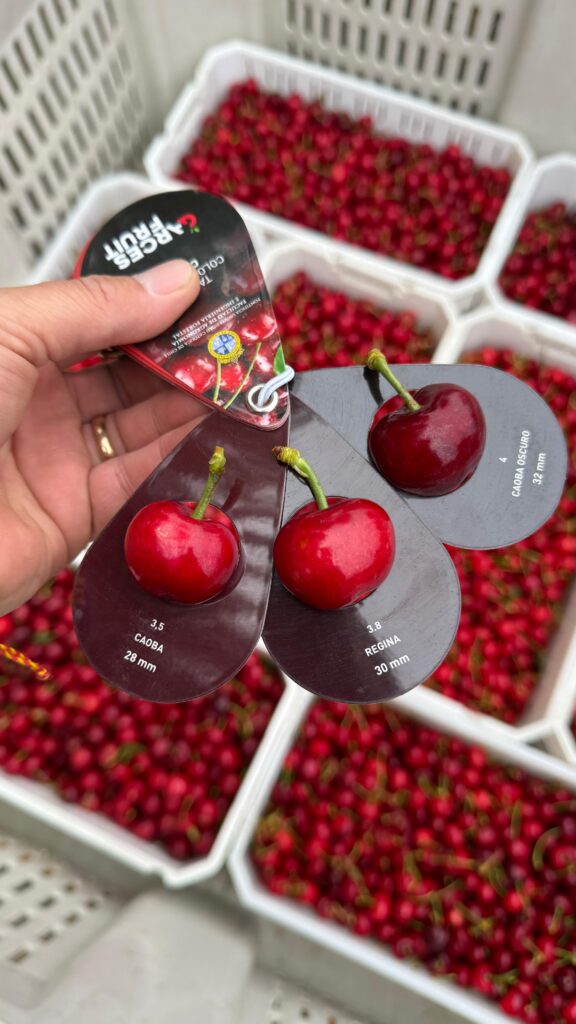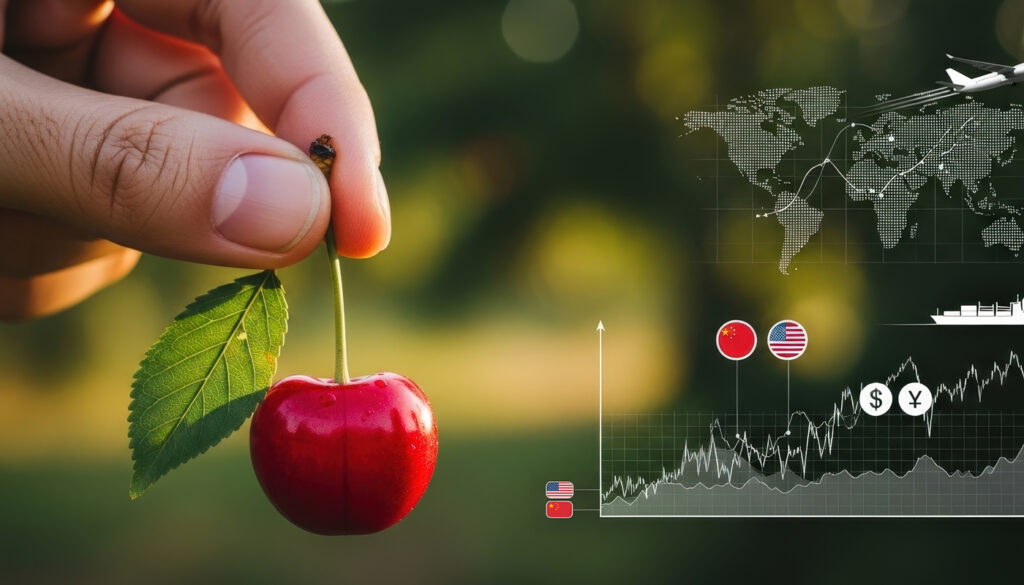
Stefano Predieri 1*, Ramdane Dris2, Lars Sekse3 and Francesca Rapparini1
Edited and adapted by Carlos J. Tapia T. Technical Director of Avium and Content Director of SmartCherry.
1 Institute of Biometeorology, Bologna Section. IBIMET-CNR Bologna, Italy 2 Department of Plant Production, Horticulture Section, University of Helsinki, Finland. 2 World Food Rd Ltd. Meri-Rastilantie 3 C, FIN-00980. email:[email protected]. 3 Norwegian Crop Research Institute, Ul
Extract
Cherry production is geographically limited to temperate areas with winters that are cold enough to meet the species' requirements and summers that allow the development of high-quality fruit. Chilling studies have shown its influence on vegetative and reproductive growth, and that the use of dormancy breakers such as hydrogenated cyanamide can replace chilling to some extent in some varieties.
Spring frosts and adverse weather conditions during flowering caused a reduction in fruit production, while high temperatures during pistil differentiation cause fruit malformation, the latter problem being reduced by the use of sprinkler irrigation. The supply of water and nutrients to the trees is important in the period that includes flowering, fruit set and harvest, but also in the post-harvest period when floral differentiation occurs.
Balancing the supply to both vegetative and reproductive organs that act as sinks is crucial. It can be influenced by bioregulators such as gibberellic acid. Tree size is mainly controlled by the choice of rootstock of which many are available through ongoing trial programmes. Pruning is used to control tree size as well, but can cause lesions that are difficult to heal, while growth regulators such as paclobutrazol have negative environmental effects. Nutrient supply to cherry trees is highly dependent on soil and rootstock type.
Keywords: cherry, productivity, environmental factors, orchard management, rootstock.
Introduction
Physiological management of the cherry tree (Prunus avium L.) should be aimed at achieving both quantity and quality, supporting carbon translocation and partitioning into reproductive structures, without compromising vegetative growth. Cherry production is strongly influenced by climatic conditions during flowering, while yield in quantity and quality depend on light distribution in the canopy. Cherry is grown commercially in over 40 countries, with Turkey, USA, Iran, Germany and Italy being the major producers. Low winter temperatures and a short growing season limit the upper and lower latitude growing areas in both hemispheres. In the southern hemisphere, cherries grow as far south as 46-47° in Patagonia (Chile and Argentina) and to 45-46°S in the Otago district of New Zealand. In the northern hemisphere, the Scandinavian peninsula is extreme in this respect, with cherries grown commercially at 61°N. Chilling requirements limit the upper limits for successful cherry cultivation at the Tropic of Capricorn in the Southern Hemisphere and the Tropic of Cancer in the Northern Hemisphere. Cherry production is highly affected by the susceptibility of the fruit to rain cracking, caused by water absorption through the skin. This phenomenon is often addressed as the major problem limiting profitable cherry production in many cherry production areas of the world. A complete account of cracking is beyond the scope of this paper. This review presents the status of current knowledge on the influence of environmental conditions and orchard management on cherry productivity.
Environmental factors
Winter temperatures and chilling requirements: Successful cherry production levels are achieved when a warm growing season is followed by a winter cold enough to break dormancy. Studies on cv. 'Stella' showed that increasing the length of the chilling period significantly reduces bud break time, and stimulates bud break frequency and vegetative growth. In addition, chilling increases flower size, pedicel length, and fruit set. When cherry crops located in temperate climate areas cannot meet their chilling requirements, hydrogenated cyanamide (CH) can be applied instead.2N2). However, as seen in experiments carried out in extreme situations such as northwestern Mexico, the capacity of cyanamide to break dormancy will depend on the specific crop. Treatments with 25 g. Kg.-1 gave positive results in 'Bing', 'Van', and 'Stella', while limited responses were observed for 'Hedelfingen' and 'Emperor Francis' and in 'Sam' where cyanamide was not effective as a replacement for cooling.14.
Effects of climatic conditions on fruit development and production: Spring frosts can cause wounding of cherry blossoms, while rain and low temperatures negatively influence bee pollination activity and consequently fruit set. Roversi and Ughini found that adverse weather conditions reduced fruit set at rates depending on the genotype, with self-fertile cv. Stella being the only unaffected, while early flowering varieties recorded low fruit set.
High temperatures (over 30°C) during pistil primordium differentiation (from 100-110 DAPF in Chile; January) cause malformations leading to the production of double fruits. The period of maximum sensitivity to the induction of double pistils is in the transition from sepal to petal differentiation.
Garden management
Tree physiology and productive efficiency: The productive efficiency of cherries depends on the assimilation of supply and storage and the ability to translocate and partition carbon (mainly reserve carbohydrates such as starch) within the reproductive structures without compromising vegetative growth. When cropping is too heavy, shoot, leaf and trunk diameter growth are reduced, and even cold hardiness may be reduced by lack of carbohydrate storage. Trees with heavy cropping have both reduced foliage development and increased trunk girth. The cherry has a double signoidal growth curve, divided into three stages: stage I, the period of cell division; stage II, the slow growth and pit hardening stage; and stage III, the period of cell elongation, when 50-80% of fruit growth occurs. Fruit and shoot growth occur at the same time, with foliage and fruit often competing as sinks for the same carbon sources in the early growing season. Fruit strength in terms of demand for carbon assimilates is greatest during stage III. Cherries have a relatively short bearing period when compared to other temperate fruits, lasting only about two months from flowering to fruit ripening. The remainder of the growing season passes without any fruit on the tree. However, it should be noted that floral differentiation generally begins immediately after harvest in the same year as harvest, so the postharvest period is of utmost importance for the following year's performance. The tree must have adequate water and nutrient supply at this important stage. On the other hand, conditions that produce vigorous growth such as N-induced growth stimulation, pruning or GA3 application increase the ratio of vegetative to reproductive buds.
Cherries are much smaller than most other fruits, making it essential that numerous flower buds form, establish, and eventually mature into fruit to achieve commercially economical yields. On the other hand, large fruit are required to access lucrative markets, therefore, physiological management of the tree should be geared toward maximizing these parameters. The leaf-to-fruit ratio can be adjusted through pruning, as the primary management of load regulation, to favor fruit enlargement. Canopy management should include consideration of the influence of light on flower bud differentiation, fruit development, and crop quality traits.
The use of plant bioregulators has been widely tested for their specific effects on cherry ripening and crop quality. The use of gibberellic acid (GA)3) is an established practice in some parts of the world to extend and/or delay the harvest period. High volume foliar applications contain 20-30 ppm GA3 slowing the development of red color by about 3-4 days, and up to 7 days. The author highlights the positive effect in reducing susceptibility to rain cracking and postulates this effect as correlative with the delay in fruit ripening. However, GA3 may have some undesirable effects such as reduced floral differentiation in the season following treatment.
The use of dormancy breakers such as Calcium Cyanamide (CCN)2 Ca) has shown to have the ability to anticipate flowering and fruit ripening. For this purpose, the effects of hydrogenated cyanamide (CH2 N) were tested.2) in the cv. 'Ferrovia'. In this series of experiments, the commercial product 'Dormex'® (520 g kg-1 w/v hydrogen cyanamide, SKW, Trostberg) was used experimentally compared with hydrogen cyanamide concentrations of 25, 30, and 40 g kg-1. The highest dose caused an earlier flowering period of about 13 days and a fruit ripening period of 6-7 days. A consistent increase in the homogeneity of fruit ripening, reducing the need for multiple harvests, was also observed in the cyanamide treatments on trees, compared to the untreated control, with no evidence of damage to fruits or vegetative organs.
Controlling tree size: Small-sized trees are of great importance for high-density cherry planting systems; they are easier and less expensive to manage, harvest earlier and generally produce better quality fruit than traditional-sized trees. In addition, small trees offer opportunities to cover plants against potential damage caused by rain or birds. Selection of compact cherry clones through mutagenesis has provided some interesting compact cultivars derived mainly from developments in Canada and Italy. Use of growth regulators such as paclobutrazol (PP.333 = Cultar) could provide some help in size control, providing a more compact tree habit. However, their application to soil raises environmental impact concerns due to their chemical persistence and long-lasting residue in soil. Along with concerns about consumer health and environmental impact, growth regulators such as diaminozide, CEPA and paclobutrazol have provided disappointing results in terms of their short duration and high variability.
Pruning can help control tree size, however, inappropriate use of pruning techniques such as large branch cutting or heavy winter pruning has raised concerns about the use of this technique because it results in large-scale lesions that are slow to heal. Kappel et al. tested the effects of pre- and postharvest summer pruning on young cv. 'Sweetheart' trees grafted onto Mazzard rootstock by removing either 1/3 or 2/3 of the current season's growth on trees 4 to 7 years old in the field. The highest yields were obtained with the preharvest treatment and with the removal of 1/3 of the vegetative mass, with no adverse effects on average fruit mass. The authors attribute the lower yields resulting from postharvest pruning to the short interval between pruning and leaf fall, which resulted in reduced carbohydrate accumulation. The more severe pruning (2/3 of the current year's vegetation) has probably negatively affected carbohydrate production and location and reduced the number of saplings. Partial branch breakage, root pruning or root restriction could provide alternative strategies to control cherry tree size.
Rootstock choice is one of the most important factors in controlling tree size and management in cherry. Dwarf rootstocks are necessary to control the size of trees planted in high density systems and offer opportunities for easy rain cover against splitting. However, rootstocks that are dwarf and also induce early and consistent crops of high quality fruit are not yet fully developed for cherries. A detailed evaluation was carried out at East Malling, UK, comparing several rootstocks with 'Colt'. In particular, the authors indicated that 'Gisela 6', 'Gi 195/40', and 'Weiroot 10' were of value from a more extensive evaluation as having higher induced yield, earliness, and yield efficiency when compared to Colt. Several of the rootstocks tested produced dwarf trees. However, some of these had poor bud break or exhibited poor longevity. Only 'G 258' (Prunus mugus L.) showed potential to become a promising rootstock, reducing tree size by about 50% compared to 'Colt'. However, the authors indicated that 'G 258' presented some problems related to propagation difficulties and a certain degree of sensitivity to cold injury. Two rootstocks, 'MaxMa 14' and 'MaxMa 97', had the most significant effect in controlling tree size by inducing a semi-dwarf habitat, while 'Damil' induced an excessive reduction in tree growth under the growing conditions of this study. In Germany, Weber 26 used an intensive orchard management approach with dwarf rootstocks limiting tree height to 4 m. Axis and super-axis training systems were reported to have shown potential to be commercially successful with the use of dwarf rootstocks such as 'Gisela 5', 'Weiroot 158', and 'Weiroot 72'.
Fertilization and irrigation: Agronomic factors interact in determining successful management of a cherry orchard with fertilization and water availability being the main issues. Water and nutrients must be supplied not only at harvest, but also during postharvest to support bud differentiation. Nitrogen content must also be maintained postharvest to provide nitrogen storage in woody organs essential for flowering and early leaf growth the following spring. Potassium deficiencies occur periodically in cherries under most production conditions, while deficiencies of phosphorus, magnesium, calcium and copper are not as common. Cherries should usually contain approximately 10-12.0 mg Ca 100 g-1 in fresh weight. Ca concentrations in fruit have been implicated in determining sensitivity to rain-induced splitting at harvest time and postharvest fruit potential. In some cases cherries are also susceptible to zinc deficiency, which causes a reduction in leaf size and premature leaf drop. Fruit size and soluble solids content are severely reduced. Zn deficiency is more common when soil pH is relatively high, but shortages have also been reported in slightly acidic soils. The rootstock plays not only a role in controlling tree growth, but determines its adaptation to soil conditions and greatly affects the nutritional status of the cherry. Ystaas and Frøynes, observed low K and N concentrations and high Ca and Mg concentrations at various ages on 'Colt' than those growing on 'Charger' and 'F 12/1' Mazzar clonals. Sitarek et al. found in 'Colt' higher concentrations of Mg and Ca and lower concentrations of K compared to Mazzard. The effects of rootstock on leaf mineral concentration were also studied by Neilsen and Kappel, who likewise found that 'Colt' produced higher levels of Mg and Ca in leaves of cv. 'Bing'. Similar results, with 'Colt' exhibiting higher contents of Mg and Ca and lower concentrations of K and N were observed when 'Colt' was compared to the rootstock 'Adara' (Prunus cerasifera L.) and to several other rootstocks. An additional factor to be considered in the choice of rootstock is the replanting situation which may affect the performance of the tree, depending on the rootstock used. Since large cherries are the most favored in the market, cherry plants are generally irrigated to minimize the water deficit of the plant. Drought influences the distribution of dry matter: if drought occurs in spring, vegetative growth is affected, while during the final wave of fruit development (stage III) drought can affect both budding and fruit growth.. Responses of cherry trees to severe drought were studied in central Washington State, USA. Trees were irrigated at 100%, 50%, or 15% evaporation rates. Trees irrigated at half their requirement levels produced normal yields and fruit size in the treatment year and in subsequent years. Wilting was observed in trees irrigated at 15% evaporation in mid-September, followed by an early drop of most leaves. When normal irrigation was restored the following year, branches died back and temporary wilting was observed. It took a few years for these trees to appear normal again, and after three years, the trees were producing normally.
Conclusions
To achieve commercially economical yields, cherry cultivation must carefully combine fruit yield and quality. Physiological management of the tree must be geared to achieve both quantity and quality by supporting carbon translocation and division in reproductive structures without compromising vegetative growth, while yield quantity and quality depend on light distribution in the canopy and on assimilating supply and storage. Among the environmental factors affecting cherry cultivation, the physiology of the chilling requirement and the agronomic practices necessary to meet it would require further study to extend cherry cultivation to warmer regions where early harvests can be produced and the economic benefits that can be obtained by the fruit grower increased. A rational choice of cultivars, rootstocks, training systems and water management regime must be pursued to allow satisfactory yields based on the balance between the need for a large number of fruits per tree and the importance of individual cherry size for market price. Cherry cultivation can benefit from advances in the understanding of this physiology, which should be the basis for developing more efficient orchard management techniques. Efforts should be directed towards optimizing fruit productivity and quality through a choice of production areas, crops and production management techniques.









